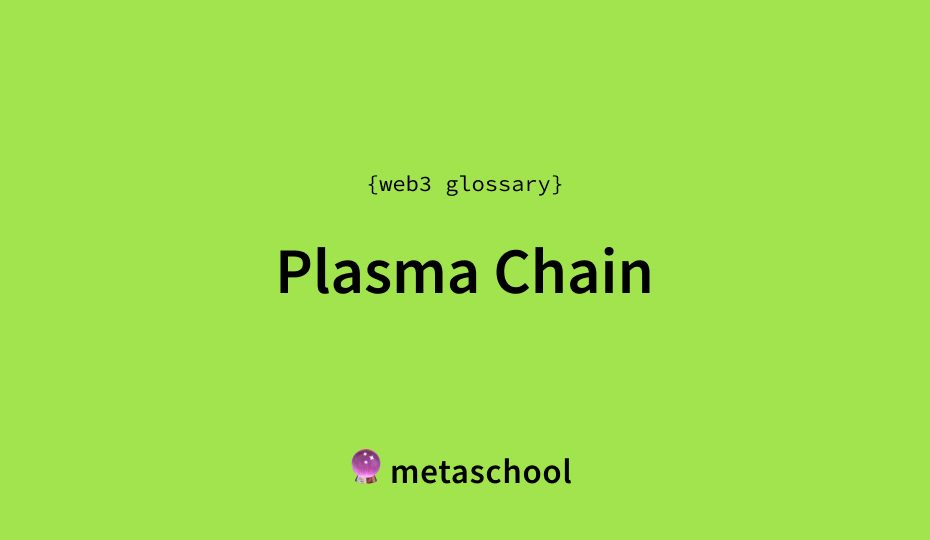Table of Contents
What is a plasma chain?
A plasma chain or plasma is similar to a blockchain with its own validation mechanism. It executes transactions off-chain meaning it uses a system other than the mainstream blockchains such as Ethereum and Bitcoin.
A plasma chain is a subsidiary of the Ethereum network and is connected to Ethereum Mainnet. It was introduced by the co-founder of Ethereum, Vitalik Buterin along with Joseph Poon to scale the Ethereum network. Scaling in the blockchain is a process through which the capacity of a blockchain network to handle a larger number of transactions per second (TPS) is increased.
The idea of an off-chain in cryptocurrency originates from the concept of creating ‘child’ blockchains. With plasma, Ethereum now serves as a parent blockchain and a plasma chain as a child blockchain. Think of it as Alphabet and Google, its parent company. The only difference is that Google and Alphabet have somewhat different roles to play.
Creation and workings of a plasma chain
Based on the phenomenon of creating secondary chains, making sure they are as closely connected to the main chain as possible and giving them a hierarchical status, plasma was created with the layer-2 scaling solutions technology that enhances the efficiency of the main blockchain.
Plasma is a product of smart contracts and Merkle trees. Merkle trees in blockchain are the driving force behind the creation of child chains. Each chain can be seen as a separate smart contract with customized features and what have you. The technology used to create these chains allows you to create multiple chains and assign them different tasks. Think of it as a family of chains – each given different chores to do.
Features of a plasma chain
Some of the features of the chain has have already been mentioned but don’t worry, we’ll reiterate:
- Tha chain’s concept is not limited to Ethereum only. Different blockchains can also use it and make as many child chains as they require. Thus, interoperability is a significant feature.
- The fact that a plasma chain can increase the scalability – transactions per second (TPS) rate – of a blockchain makes it even more useful.
- Created by using smart contracts (which happen to have peaked security measures), plasma chains are almost as secure as any main blockchain network. Moreover, this chain is also a decentralized network.
- Lastly, a plasma chain uses a consensus mechanism which is seen to have increased efficiency in a network on the blockchain. Thus, it is also efficient in its workings.
Differences between plasma chains and layer-1 cryptocurrencies
The main difference between plasma chains and layer-1 cryptocurrencies is that a plasma serves as a layer-2 network used as a scaling solution for a certain blockchain whereas layer-1 blockchains work independently. We have broken down some differences for you in the table below.
| Plasma Chain | Layer-1 Cryptocurrencies |
| High scalability | Limited scalability |
| Higher transactions per second (TPS) | Lower transactions per second (TPS) |
| Lower security guarantee | Higher security guarantee |
| Less decentralized | More decentralized |
| Limited smart contract support | Full smart contract support |
| Low cost per transaction | Higher cost per transaction |
| Fast finality | Slow finality |
Problems associated with a plasma chain
There are not many risks associated with plasma chains but as an evolving technology, the plasma chain may be subject to malfunctions and disorders which is one down-side of it.
Secondly, it is a new technology. There are countries where even mainstream cryptocurrencies are banned, let alone a child chain. For example, in countries like Bangladesh and China where virtual currency is either restricted or banned from the market, people who still use or are associated with cryptocurrency in any capacity are fined and in some cases, even imprisoned. Thus, there may be legal consequences for using cryptocurrency in such countries.
Use cases of a plasma chain
Plasma chains are almost at par when it comes to their adoption by different sectors in the world. Be it DeFi dApps, decentralized gaming apps, supply chain management, and healthcare, use cases of plasma chains are being researched and attempted at being implemented every day.
An example of a plasma chain is OmiseGo (OMG). It is an online exchange and payment platform that has been using these chains for cost-effective transactions. OMG is totally built on the Ethereum blockchain and supplemented by its plasma chain.
As of now, there are not many companies or startups using plasma chains but it has been researched and researchers have reached the conclusion that plasma chains can very well be used in telemedicine and medical research.
All in all, a plasma chain ensures scalability, charges lower fees, enhances operations speed, is compatible with on-chain scaling solutions and eliminates unnecessary data from the main chain.
What are the advantages of Plasma Chain over traditional blockchains?
Some of the advantages that Plasma Chain has over traditional blockchains include greater scalability, speed (Plasma can be super fast and quick with transactions) because it has a greater TPS (transactions per second) rate, low transaction costs. Moreover, Plasma Chain is safer and more secure than traditional blockchains.
What are the real-world use cases for Plasma Chain?
Plasma Chain’s real-world use cases involve revolution in the decentralized finance realm with the help of its fast and cost-effective transaction system. Similarly, the gaming industry could also greatly benefit from Plasma Chain and so can the decentralized supply chain management systems to ensure smooth supply of goods and avoid any kind of counterfeiting.
How does Plasma Chain handle consensus?
Plasma Chain working on a Proof-of-Authority (PoA) consensus mechanism is like Plasma Chain running on a Proof-of-Work (PoW) consensus mechanism. Thus, how Plasma Chain handles consensus is based on what kind of consensus is being followed. If it is PoW, there will be miners. If it is PoA, there will be validators.
